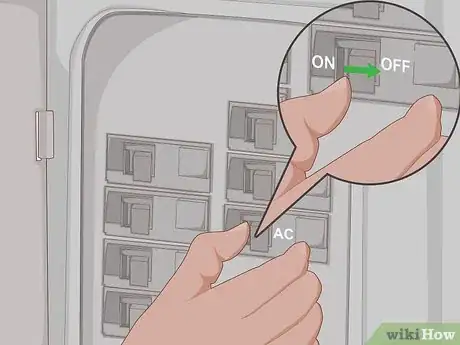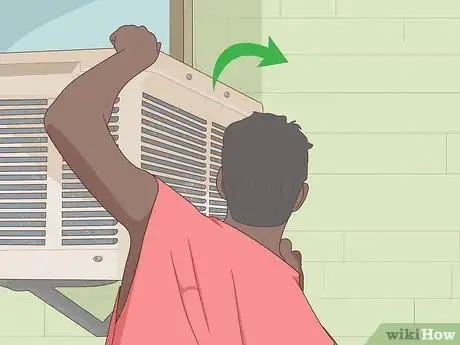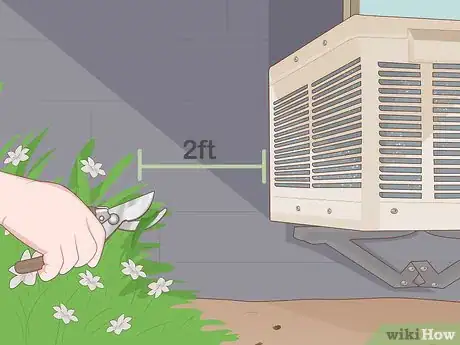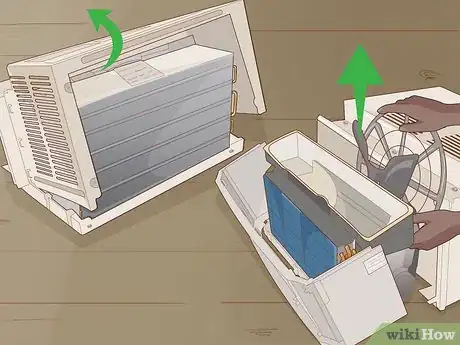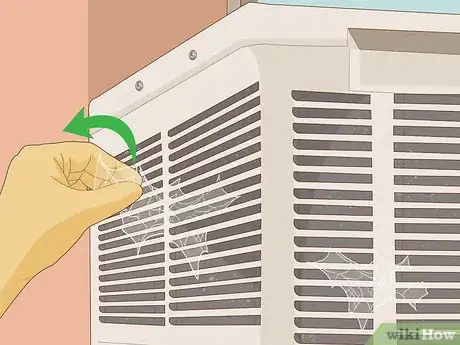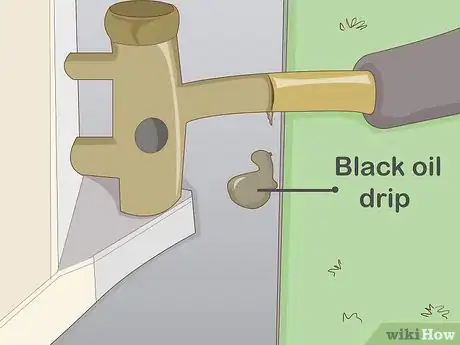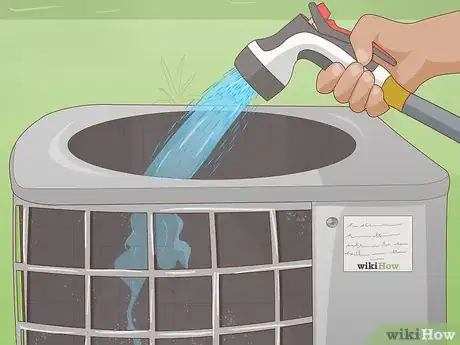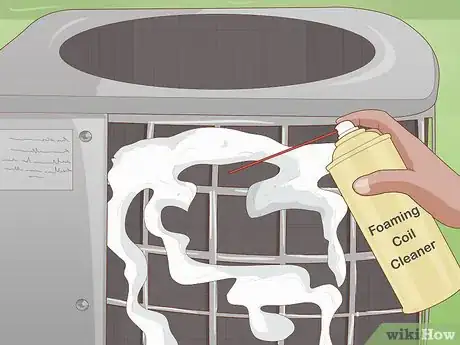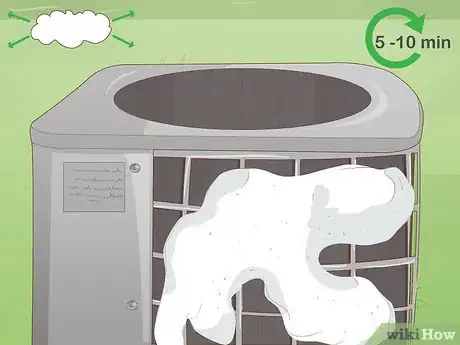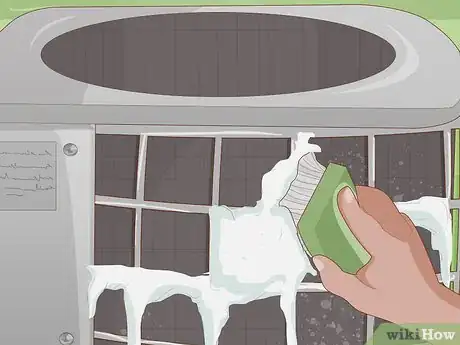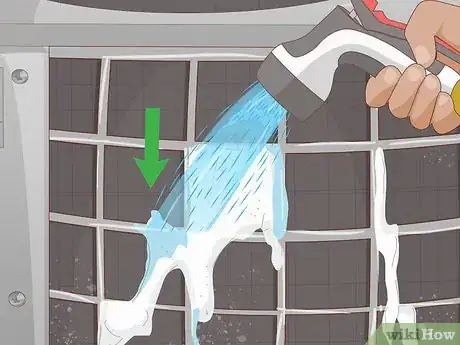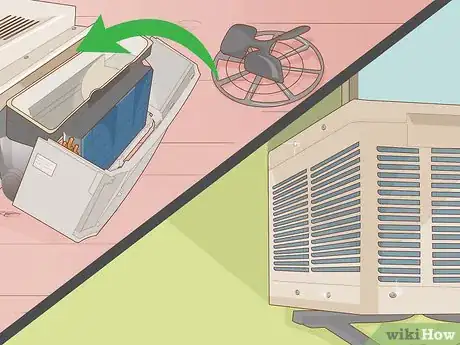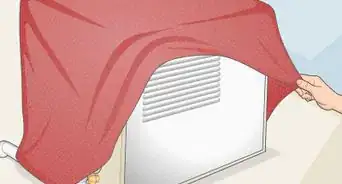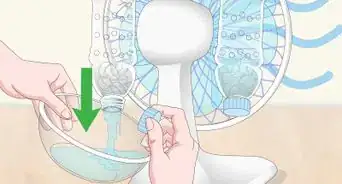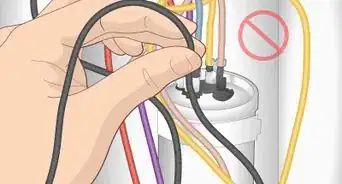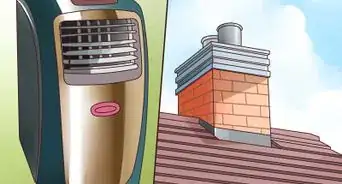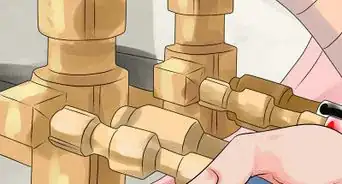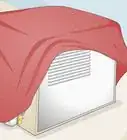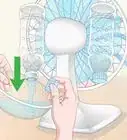This article was co-authored by Victor Belavus. Victor Belavus is an Air Conditioning Specialist and the Owner of 212 HVAC, an air condition repair and installation company based in Brooklyn, New York. In addition to HVAC and air conditioning units, Victor also specializes in furnace repair and air duct cleaning. He has over 10 years of experience working with HVAC systems.
wikiHow marks an article as reader-approved once it receives enough positive feedback. In this case, 90% of readers who voted found the article helpful, earning it our reader-approved status.
This article has been viewed 547,032 times.
Cleaning your air conditioner's condenser coils regularly will let it run cooler with less energy and make you feel more comfortable. The best time to clean your air conditioner is in the spring, just before you need to start using it for the first time in the year. If you spot any problems with your air conditioning unit as you clean it, contact a certified technician to repair them.
Steps
Accessing the Coils
-
1Shut off the power to the air conditioner. Most outdoor air conditioning units have an appliance shut off box situated nearby. Open the door on the box and flip the switch or remove the fuse to cut power to the air conditioner. Window and wall units can usually just be unplugged.[1]
- If you have no shut off box, or if you just want an extra layer of safety, turn off the power at the circuit breaker in your house.[2]
- Never attempt to work on an air conditioning unit without first disconnecting the power.
-
2Take the air conditioner out of the window (when applicable). Window units can usually be cleaned just like central air units, but the coils will be easier to access if you remove the unit from the window before you start working on it.[3]
- The layout of window units is different than indoor or outdoor central air units, but the functions and parts are effectively the same.
- Be sure to lay the air conditioner on a flat surface, preferably outdoors, for cleaning.
Advertisement -
3Trim foliage so it isn't closer than 2 feet (0.6 meters) to the unit. As the seasons change and leaves fall from trees, they can collect on the air conditioning unit or even slip inside through the heat dissipation vents. Once you've trimmed the branches and bushes, be sure to clear the entire area around the unit.[4]
- Loose leaves and dirt surrounding your air conditioning unit can be blown through the vents, collecting around the coils and limiting how effective they can be.
- Cleaning the area of debris and foliage will also improve airflow into the air conditioning unit.
- Be sure to wear safety glasses and gloves when trimming trees and bushes.
-
4Remove the cover from the air conditioner unit. Depending on your air conditioner, you will need either an appropriately sized socket or a screwdriver to remove the bolts or screws securing the cover in place. Once you have them removed, pull the lid off of the air conditioning unit.[5]
- The user manual will tell you what size socket or screwdriver you need.
- Set the screws aside somewhere safe.
-
5Pull the cover and fan from the unit (when applicable). Some air conditioning units will have a grill with a fan attached to it mounted on the top. Remove the screws and pull the grill out from the top of the open unit. The fan is usually attached, so be sure to support it as you remove the assembly to avoid letting it hang by its electrical connections.[6]
- In air conditioners where the fan stays in place, avoid spraying it directly with water as you clean.
Cleaning Out the Air Conditioner Unit
-
1Clear out the drain line (when applicable). Many indoor and outdoor air conditioning units will have a drain or drain line in the bottom corner of the drain pan at the bottom of the unit. It will look like a hole in the pan, and on some models, there will be a nozzle with a rubber or plastic line coming out of the other side. Make sure the drain isn't blocked or plugged so water and cleaner can drain as you clean the coils.
- If it has a drain line that seems to be clogged, pour a 50/50 water and bleach solution in the drain pan and wait a few minutes to clear it out.
- You can purchase algae tablets from air conditioning specialty retailers to prevent algae from growing and clogging the drain.
-
2Remove large debris from inside the unit with your hands. With the cover set aside, you can look around at the air conditioning coils and make sure there's no large bits of debris that may have worked their way into the unit. It's not uncommon for leaves, sticks or bugs to find their way into the interior of an outdoor unit.[7]
- If you'd prefer, you can use a soft brush to clear out the debris, instead.[8]
- You might want to use a shop vacuum for things like spiderwebs if you're uncomfortable removing them by hand.
- Be careful touching the fins, or blades, on the coil. They bend easily.
-
3Look for signs of oil leaks. Most compressors and motors in modern air conditioning units are maintenance free, but keep an eye out for dark drip marks on the bottom of the compressor housing or beneath it. That may be a sign of an internal oil leak.[9]
- If the compressor or motor are leaking oil, it will need to be repaired by a certified technician.
- Don't attempt to over-tighten connections on the compressor or motor, as you may worsen the leak.
-
4Spray the coil with water from the hose if its outdoors. Be sure to use your garden hose and not a power washer, as too much force could bend the fins inside the air conditioning unit. Spray the coils down to remove any loose dirt and prepare the coil for a spray cleaner.[10]
- If the fan is still in place, avoid spraying it or its wiring directly with the hose.
- If your unit is indoors, you will need to use a different kind of cleaner for the next step.
Using a Foam Cleaner on the Coils
-
1Apply a foaming coil cleaner. If your unit is outdoors, apply the foaming coil cleaner to the coils while they're still wet from the hose. Indoor units will need to use water-less coil cleaner, which works the same, but tends to be a bit more expensive.
- Spray directly into the coils and cover them completely.
- The cleaner should begin to foam up immediately upon contact with the coils.
- If you don't have a commercial coil cleaning solution, spray the coils with a mixture of mild dish detergent and water.[11]
-
2Soak the coils in cleaner for 5-10 minutes. Once the coils are completely covered in cleaner, you should let the foam continue to expand and pull the grime off of the coils. While 5-10 minutes is generally considered acceptable, the instructions on your specific cleaner may call for a different amount of time.[12]
- You can apply more foaming cleaner during this soaking time if it begins to drip away from the top of the coils.
-
3Use a fin comb to clean and unbend coil fins. Because bent fins are such a common issue, air conditioner wholesale retailers sell a specialized tool called a fin comb to help return the fins to their normal working order. Slide the bristles of the comb into the fins where they're open, then run the comb down along the fins to straighten any that are bent.[13]
- There are limits to what fin combs can do, but it should straighten most fins back to normal provided the damage isn't too extensive.
- This will also clean dust and debris out from the fins.
-
4Use the hose to rinse the cleaner off of outdoor units. After the cleaner has soaked for long enough, spray the hose slowly back and forth across the coils to rinse the foam off. It will likely take a few slow passes with decent water pressure to get all the foam to rinse away.[14]
- As the foam comes off of the coils, it will take dirt and grime with it, leaving the coils clean.
- Water-free foam cleaner will condensate off of the coils when you turn the air conditioner back on.
-
5Reassemble the unit. Once you've thoroughly rinsed the cleaner from the coils (in outdoor units) return the fan and covers to where they belong and insert the screws or bolts that hold each in place.[15]
- Once everything is reassembled, you can turn power back on for the air conditioning unit.
- If you used water-free cleaner, turn on the unit to allow the cleaner to condensate away.
Expert Q&A
-
QuestionHow do you remove debris from an air conditioner?
 Victor BelavusVictor Belavus is an Air Conditioning Specialist and the Owner of 212 HVAC, an air condition repair and installation company based in Brooklyn, New York. In addition to HVAC and air conditioning units, Victor also specializes in furnace repair and air duct cleaning. He has over 10 years of experience working with HVAC systems.
Victor BelavusVictor Belavus is an Air Conditioning Specialist and the Owner of 212 HVAC, an air condition repair and installation company based in Brooklyn, New York. In addition to HVAC and air conditioning units, Victor also specializes in furnace repair and air duct cleaning. He has over 10 years of experience working with HVAC systems.
Air Conditioning Specialist Use your hands to remove large debris or use a soft brush to get out the debris.
Use your hands to remove large debris or use a soft brush to get out the debris.
Warnings
- If you spot any problems during the cleaning process, such as an oil leak or damage to the refrigerant coolers, contact an air conditioner service technician.⧼thumbs_response⧽
Things You'll Need
- Screwdriver
- Whisk broom or brush
- Garden hose with sprayer nozzle
- Foaming cleaner (biodegradable)
- Fin comb (optional)
- Safety glasses
References
- ↑ https://www.familyhandyman.com/heating-cooling/air-conditioner-repair/cleaning-air-conditioners-in-the-spring/view-all/
- ↑ Victor Belavus. Air Conditioning Specialist. Expert Interview. 6 May 2020.
- ↑ https://www.familyhandyman.com/heating-cooling/air-conditioner-repair/how-to-clean-a-room-air-conditioner/view-all/
- ↑ https://www.energy.gov/energysaver/maintaining-your-air-conditioner
- ↑ https://www.familyhandyman.com/heating-cooling/air-conditioner-repair/cleaning-air-conditioners-in-the-spring/view-all/
- ↑ https://www.familyhandyman.com/heating-cooling/air-conditioner-repair/cleaning-air-conditioners-in-the-spring/view-all/
- ↑ https://www.bobvila.com/articles/how-to-clean-ac-coils/
- ↑ Victor Belavus. Air Conditioning Specialist. Expert Interview. 6 May 2020.
- ↑ https://www.familyhandyman.com/heating-cooling/air-conditioner-repair/cleaning-air-conditioners-in-the-spring/view-all/
- ↑ https://www.bobvila.com/articles/how-to-clean-ac-coils/
- ↑ Victor Belavus. Air Conditioning Specialist. Expert Interview. 6 May 2020.
- ↑ https://www.bobvila.com/articles/how-to-clean-ac-coils/
- ↑ https://www.energy.gov/energysaver/maintaining-your-air-conditioner
- ↑ https://www.bobvila.com/articles/how-to-clean-ac-coils/
- ↑ https://www.bobvila.com/articles/how-to-clean-ac-coils/
- ↑ https://www.bobvila.com/articles/how-to-clean-ac-coils/
About This Article
To clean air conditioner coils, turn off the unit and remove the cover to access the inside of the unit. Once you're inside, use your hands to clear out large debris, like leaves, twigs, and insects. Then, spray the coil with water to loosen any dirt that's caked on. When the coils are wet, spray a foam cleaner and let it soak for 5 to 10 minutes. If any of the air conditioning fins are bent, use a fin comb to reshape them, and then spray the foam off of the coils before reassembling the unit. For tips on dismantling the unit and maintaining window units, read on!
